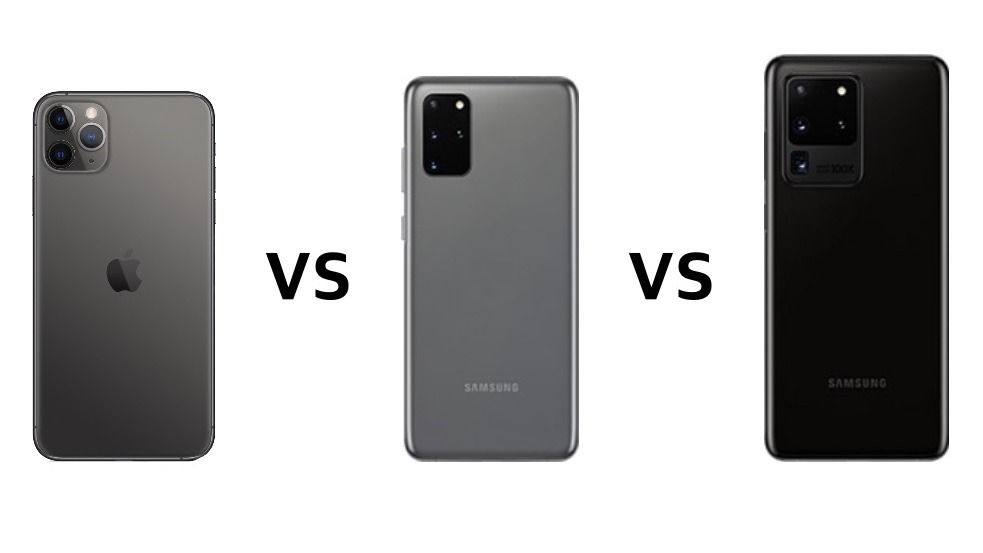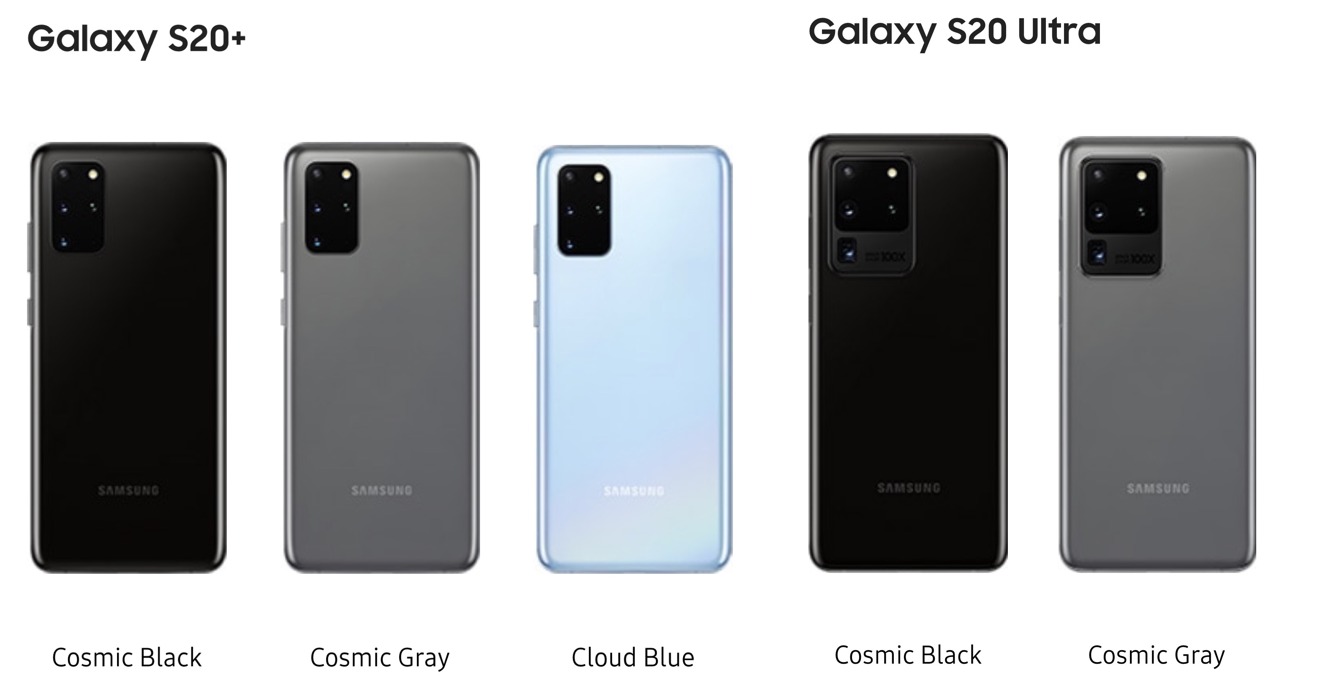iPhone 11 Pro Max vs Samsung Galaxy S20+ - the best ultra-premium smartphones
Samsung has made sure that Apple's iPhone 11 Pro Max and the new Galaxy S20+ are direct competitors. With Samsung pushing further into the ultra-premium range with the Galaxy S20 Ultra, does Apple still offer enough to the prosumer six months after the release of the iPhone 11 Pro Max?
The iPhone 11 Pro Max was launched in late September 2019 alongside the iPhone 11 and iPhone 11 Pro. The iPhone 11 Pro Max is at the top of Apple's iPhone lineup, but its bigger screen and battery are all that set it apart from the smaller iPhone 11 Pro. The current iPhones in the lineup are capable of 4K 60fps video, algorithmically generated photos using a new neural engine in the A13 Bionic chip, and have better screens than ever seen in an iPhone before.
Samsung announced four new smartphones at their Galaxy Unpacked 2020 event and gave us some insane specs to examine. This will compare the Galaxy S20+ and Galaxy S20 Ultra to the iPhone 11 Pro Max, which are the tops of their respective lineups. The new Samsung phones have an all new rear camera system, have relocated the front facing "hole punch" camera to the top center of the screen, have an aluminum and glass frame, and feature a new flat screen rather than one that curves off the edge of the device.
Comparing the specs of iPhone 11 Pro Max vs Galaxy S20+ vs Galaxy S20 Ultra
Samsung debuted three new phones in their product line during the Galaxy Unpacked event. Instead Samsung aimed higher than it ever has before with an ultra-premium phone that does not have a direct price competitor from Apple. The iPhone 11 Pro Max does pack some impressive specs, however, despite being half a year older.
| iPhone 11 Pro Max | Galaxy S20+ | Galaxy S20 Ultra | |
|---|---|---|---|
| Price | $1,099 | $1,199 | $1,399 |
| Dimensions (inches) | 6.22 x 3.06 x 0.32 | 6.37 x 2.9 x 0.31 | 6.57 x 2.99 x 0.35 |
| Weight (ounces) | 7.97 | 6.56 | 7.76 |
| Processor | A13 Bionic | Snapdragon 865 | Snapdragon 865 |
| RAM | 4GB | 12GB | 12GB 16GB w/512GB storage |
| Storage | 64GB, 256GB, 512GB | 128GB, 256,512 add up to 1TB with microSD | 128GB, 256GB, 512GB add up to 1TB with microSD |
| Display type | 6.5-inch Super Retina XDR (OLED HDR) | 6.7-inch AMOLED Infinity-O Display | 6.9-inch Infinity-O Display |
| Resolution | 2688x1242 pixels at 458ppi | 3200x1400 pixels at 525ppi | 3200x1400 pixels at 511ppi |
| Screen refresh | 60Hz | 60Hz at full resolution 120Hz at 1080p | 60Hz at full resolution 120Hz at 1080p |
| Ports | Lightning and no headphone jack | USB-C and no headphone jack | USB-C and no headphone jack |
| Networking | 4G LTE | 5G (sub 6-GHz/mmWave) | 5G (sub-6GHz/mmWave) |
| Rear Cameras | 12MP wide angle 12MP ultra-wide angle 12MP telephoto (2x optical) | 12MP wide angle 12MP ultra-wide angle 64MP telephoto (3x optical) DepthVision Camera with Space Zoom | 108MP wide angle (12MP with Pixel Binning) 12MP ultra-wide angle 48MP telephoto (3x optical) DepthVision Camera with Space Zoom |
| Front Cameras | 12MP with TrueDepth sensors | 10MP | 40MP (10MP with Pixel Binning) |
| Battery Size | 3,969 mAh | 4,500 mAh | 5,000 mAh |
| Colors | Space Gray, Midnight Green, Silver, Gold | Cosmic Black, Cosmic Gray, Cloud Blue | Cosmic Black, Cosmic Gray |
The specs between the three premium devices are mostly similar, with Samsung pulling out some huge numbers to differentiate itself. Large batteries, more RAM, and high resolution cameras are the norm for Android flagships, but the Galaxy S20+ and Galaxy S20 Ultra take it to a new level. Despite these huge numbers from Samsung, it seems the iPhone 11 Pro Max competes well, and may offer a better value at its lower price.
Photography
iPhone 11 Pro Max
The iPhone 11 Pro Max has a three sensor array on the rear of the phone, and a front facing TrueDepth camera system. All of the cameras feature 12MP sensors capable of 4K HDR video, and slo-motion 1080p video. When recording in 30fps, the iPhone will use its fast neural engine to capture different exposures every other frame and stitch them into the 30fps video which will extend the dynamic range.
The iPhone 11 Pro Max has one of the highest rated camera systems in the industry. Each sensor and lens are calibrated in the factory to ensure that every photo and video are accurate and no distortion or change is seen when switching between them.
Software features like Live Photo, Portrait Mode, and even Animoji all rely on Apple's fine tuning of its cameras and neural engine. For iPhone, its less about specs on paper and more about the experience and usable end result.
Samsung Galaxy S20+
The Samsung Galaxy S20+ has a four sensor array on the rear of the phone and a single camera on the front. The rear sensors consist of three cameras and a time-of-flight sensor. The ultra-wide and wide angle lens are comparable to the iPhone 11 Pro Max, and are also 12MP. The telephoto lens is turned on its side and utilizes a mirror to allow more distance between the lens and sensor, thus creating a 3x optical zoom at 64MP.
The attention-grabber here is obviously that 64MP camera, and its 8K video capability. When shooting with the telephoto lens, you can use Samsung's ML run "Super Resolution Zoom" and get up to 30x zoom. This is accomplished utilizing the 10x digital crop and 3x optical zoom, just as iPhone achieves its own 10x zoom with a 5x crop and 2x optical zoom.
Samsung Galaxy S20 Ultra
While the iPhone and Galaxy phones both show some impressive features and specs, Samsung's Galaxy S20 Ultra pulls out all the stops. It has the same rear four sensor array and single front facing camera, but with the specs turned all the way up. Only the ultra-wide and TOF sensor stay the same as the Galaxy S20+ on this device.
The telephoto camera is again turned on its side, but additional optics make it a 10x optical zoom. This means when paired with the 10x digital zoom you can get a massive 100x combined zoom! While impressive, the demos show that detail loss is quite huge at this range and a tripod might be required to prevent hand shake from ruining photos. Nevertheless, an impressive spec to say the least.
The standard wide angle camera is blown up to 108MP. At first glance this probably looks like a mistake or a typo, but Samsung assures us its a genuine 108MP sensor. There is a caveat though, so no, you will not be taking actual 108MP photos, at least not by default. Samsung has implemented a recent technology called "pixel binning" which allows pixels to be essentially combined while taking a photo.
Since this device uses a 9 to 1 pixel binning ratio, you'll end up with a 12MP photo, but a more detailed and better lit photo due to the process. It will require some hands on testing to determine if this translates to noticeable increases in quality, or if its just another big numbers game.
The front-facing camera on the Galaxy S20 Ultra also has a huge spec bump. Utilizing 4 to 1 pixel binning, this camera has a 40MP sensor and shoots 10MP selfies. The front-facing camera is capable of recording at 4K on both Samsung devices as well.
Software features include Samsung's own portrait mode on the front and rear cameras. The rear camera is able to take advantage of its time of flight sensor for more accurate bokeh and object detection. A new feature introduced during the Galaxy Unboxed event, called "Single Take," allows users to pan their phone around a scene for 10 seconds while an ML algorithm takes photos and video in various formats. The final result is a bunch of different media that can be used and shared by the user, and all done without needing to decide which feature to use in the moment.
4G, 5G, and mmWave
The iPhone 11 Pro Max still runs at the same 4G LTE we've been using for years. When it launched in 2019 5G was only just seeing proper installation and activation in the biggest US cities. Even now 5G has barely trickled out into other cities in the US and a slow global rollout overall. Rumors point to a 5G iPhone this fall, but for the average user you will not notice a difference between the two anyway — today, at least.
While 5G is still being rolled out across the US, users can already get better than 4G speeds in some areas. While not the gigabit speeds promised by "full 5G," it is still much faster than the current 4G speeds, and can sometimes cross into hundreds of Mbps. This is referred to as sub-6GHz 5G and is being used alongside 4G equipment to quicken the rollout. T-mobile and Sprint are focusing on this technology.
The faster mmWave has its own limitations, and may take even longer, if ever, to roll out across the entire US. This version of 5G operates at very high radio frequencies, all the way up to 300GHz, and while it can transfer massive amounts of data very fast it can't do so efficiently. Effectively, mmWave is blocked by any material, and is only able to work within line of sight of a receiver, and at a close range. Walls, glass, and even other people can severely limit if not altogether block a mmWave 5G signal.
The Galaxy S20+ and Galaxy S20 Ultra both support mmWave and sub-6GHz signals. This means that out of the box these devices can utilize whatever 5G network is available, and will be launching across all major carriers in the US, including Verizon. Buying one of these devices will mean being future proofed for the 5G rollout, but when you'll see noticeable impact from this feature is unknown.
The "iPhone 12" that will launch in fall 2020 is rumored to have 5G capabilities. No word yet on which kind of 5G Apple will implement, if any.
Specs sheets vs reality
Apple has always gone for what works best with minimal user input. There are various camera systems and software features that all occur without a user ever touching a settings menu. Apple's approach is to let software get out of the way and offer an end result to the user that is both natural and high quality. This is the approach taken throughout iPhone and its specs.
This can be seen with how the camera operates; the user points and shoots and ends up with the best photo possible in that moment after a billion operations occur in that instant. Diving into menus to change how the camera operates is an option, but not something Apple pushes users to do.
Samsung takes the opposite approach; there are plenty of new features in their flagship devices, but some caveats as well. While the spec sheets show 108MP photos and 120Hz screens, this isn't the experience that users will actually have. First, a setting must be changed and a compromise take place, like a with the screen being 120Hz but only at 1080p.
It isn't yet known if you can force the camera to take 108MP stills, and Samsung's own documentation isn't clear, so testing is still required. Even if it is possible, due to the small pixel size, the photos likely wont come out as crisp or as bright as we'd like. And such a setting again would be buried in a menu.
While photo styling, software, OS, and other factors will weigh on a purchasers decision more than anything, it is worth noting that the experience promised on paper isn't going to perfectly reflect reality.
Due to these limitations and caveats that go along with almost every new feature announced, it is hard to say if Samsung has truly gained a leg up on the iPhone. The Galaxy S20+ is $100 more expensive than the base iPhone 11 Pro, and has very similar specs. For $50 more than the Galaxy S20+, consumers can buy an iPhone 11 Pro Max with twice the internal memory.
For the Galaxy S20 Ultra, the difference is even greater. For $50 more than the base Galaxy S20 Ultra, a consumer can get an iPhone with four times the internal storage. The camera specs and 5G make Samsung's phone stand out, but you're not getting as much as it seems.
AppleInsider reviewed the iPhone 11 Pro Max and gave it a 4.5 out of 5. Stay tuned for hands on content featuring Samsung's new phones and how they compare to the iPhone 11 Pro Max.
We'll be looking closer at Samsung's new offerings as soon as we get our hands on them. And, we'll be comparing them to Apple's 2020 lineup when the time comes as well. Meanwhile, you can see how the iPhone 11 Pro and Samsung Galaxy S20 also compared.
Where to buy
Pre-orders for the Samsung Galaxy S20, Galaxy S20+ and Galaxy S20 Ultra begin at 12:01 a.m. Eastern on Feb. 21, with Samsung offering bonus trade-in values for Apple users.
B&H will also begin accepting orders on Feb. 21 with free 2-day shipping on the Galaxy S20 models.
Meanwhile, those looking to purchase an iPhone 11 can find aggressive carrier offers in our iPhone 11 deals roundup.
 Wesley Hilliard
Wesley Hilliard















 Charles Martin
Charles Martin
 Malcolm Owen
Malcolm Owen
 William Gallagher and Mike Wuerthele
William Gallagher and Mike Wuerthele
 Christine McKee
Christine McKee
 William Gallagher
William Gallagher

 Marko Zivkovic
Marko Zivkovic








